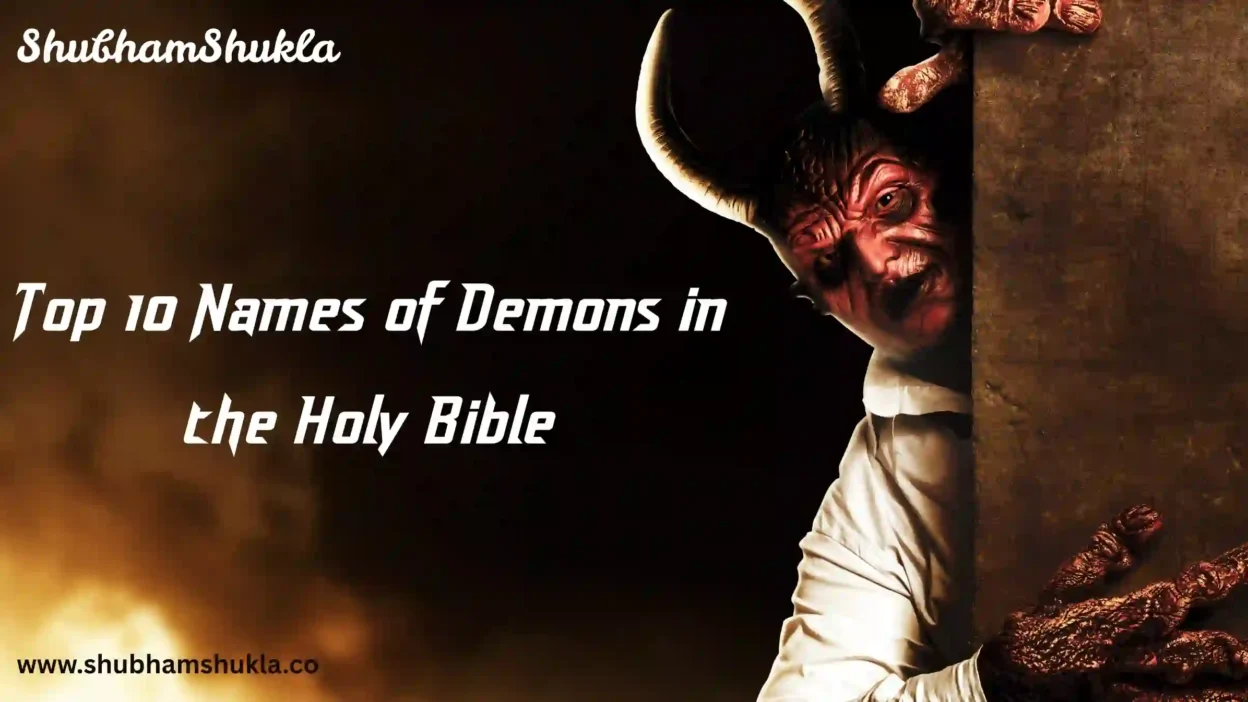The Bible isn’t just a story of light it also acknowledges the darkness. Among its pages, demons are mentioned as forces of chaos, evil, and temptation. Ever wondered who these evil beings are by name? You’re not alone. Whether you’re into theology, mythology, or just curious about spiritual warfare, this list dives into the top 10 names of demons in the Bible with backstories, meanings, and more.
- Here's a complete list of top ten demons in the bible
- 1. Lucifer – The Fallen Morning Star
- 2. Beelzebub – Lord of the Flies
- 3. Asmodeus – The Demon of Lust
- 4. Legion – Many Demons in One
- 5. Abaddon/Apollyon – The Destroyer
- 6. Lilith – A Controversial Figure
- 7. Samael – The Angel of Death
- 8. Belial – Worthlessness Embodied
- 9. Mammon – The God of Greed
- 10. Moloch – Idol of Child Sacrifice
- Final Thoughts – Names of Demons in the Bible
- Frequently asked questions
Here’s a complete list of top ten demons in the bible
1. Lucifer – The Fallen Morning Star
Lucifer is one of the most well-known figures associated with rebellion against God. Often referred to as the “Morning Star,” he was originally a high-ranking and radiant angel before pride led to his downfall.
According to interpretations of Isaiah 14:12, Lucifer sought to elevate himself above God, resulting in his expulsion from Heaven. This act of defiance transformed him into Satan, the ultimate adversary in Christian theology.
Though the name “Lucifer” itself means “light-bringer,” his fall symbolizes the consequences of pride and ambition. Today, Lucifer represents the archetype of fallen grace and spiritual rebellion in biblical literature.
You may also like: Top 10 JK Rowling Books Ranked by Readers
2. Beelzebub – Lord of the Flies
Beelzebub, often referred to as the “Lord of the Flies,” is one of the most infamous demons mentioned in biblical and Christian texts.
Originally a Philistine god worshipped in Ekron, Beelzebub was later demonized in Judeo-Christian tradition and associated with Satan himself.
In the New Testament, he is described as the prince of demons, and the Pharisees accuse Jesus of casting out demons by his power (Matthew 12:24).
His name symbolizes corruption, decay, and evil influence, often linked to filth and flies. Over time, Beelzebub became a powerful symbol of pride and rebellion against divine authority.
You may also read: 10 Essential Types of Characters in Literature (With Examples)
3. Asmodeus – The Demon of Lust
Asmodeus is often regarded in biblical and apocryphal literature as the demon of lust, frequently associated with sexual desire and temptation.
Asmodeus, who appears in the apocryphal Book of Tobit, is portrayed as a powerful and wicked demon that kills Sarah’s husbands before they can complete their marriages. His fixation on lust and jealousy makes him a figure of destructive passion.
In later demonological texts, Asmodeus is mentioned as one of Hell’s seven rulers, representing the deadly sin of desire. His appearance serves as a warning against uncontrollable desire and unethical indulgence.
You may also like: 10 Best Fiction Books to Read in 2025 (Updated List)
4. Legion – Many Demons in One
In the Bible, “Legion” is a strong term used in Mark 5:9 and Luke 8:30 to describe a man tormented by numerous demons. When Jesus asks for the demon’s name, it responds, “My name is Legion, for we are many.”
The term refers to a Roman military unit, representing overwhelming force and solidarity among evil spirits. This collective possession demonstrates the horrifying scope of demonic influence and devastation.
Jesus finally casts the devils into a herd of pigs, revealing His control over even the most powerful and destructive forces. Legion remains a powerful image of spiritual battle throughout Scripture.
You may also like: Synopsis of Haunting Adeline: Why This Dark Romance Is Gripping America
5. Abaddon/Apollyon – The Destroyer
Abaddon, also known as Apollyon in Greek, is referred to as “The Destroyer” in the Bible, specifically in Revelation 9:11.
He is described as the angel of the bottomless pit and the king of the demonic locusts unleashed during the fifth trumpet judgment.
His name symbolizes ruin and destruction, aligning with his role in biblical prophecy. Abaddon represents divine judgment and chaos, serving as a powerful figure of fear and wrath in apocalyptic scripture.
6. Lilith – A Controversial Figure
Lilith is a very disputed person who is frequently associated with demonic lore, despite the fact that her name does not occur explicitly in most canonical editions of the Bible.
She is sometimes referred to as Adam’s first wife, who rebelled against him and was expelled from Eden, according to Jewish tradition. Lilith gradually became associated with night demons, insurrection, and feminine independence.
Her account, based on legend rather than scripture, has sparked dispute among theologians, historians, and spiritual researchers.
You may also read: Top 10 R. K. Narayana Books You Must Read Before You Die rrr
7. Samael – The Angel of Death
Samael, often known as the Angel of Death, plays a complex role in biblical and mystical traditions. Despite being an angel, Samael is often associated with darkness, ruin, and seduction.
In Jewish legend, he is both a heavenly accuser and a dreadful reaper figure who executes God’s judgments. Samael, unlike traditional demons, obeys divine commands, blurring the distinction between good and evil.
His presence exemplifies the dichotomy of justice and punishment in spiritual belief systems.
You may also like: Top 15 Aadvika Pommu Novels You’ll Instantly Obsess Over
8. Belial – Worthlessness Embodied
The Bible portrays Belial as a representation of moral decay and complete worthlessness. Belial is a term that is often used in the Old Testament to refer to evildoers or illegal conduct.
Later Christian demonology personified Belial as a strong demon who stood for evil, disobedience, and dishonesty.
His name, which is sometimes translated as “without value,” emphasizes his function as a symbol of sin and ruin who persuades people to reject morality and divine truth.
9. Mammon – The God of Greed
Mammon is often depicted as the demon of greed, materialism, and wealth in biblical and Christian literature.
Though not explicitly named as a demon in the Bible, Mammon represents the corrupting power of riches when worshipped above God.
In Matthew 6:24, Jesus warns that one cannot serve both God and Mammon, highlighting the conflict between spiritual devotion and worldly greed.
Over time, Mammon became personified as a demon who tempts individuals to prioritize wealth over righteousness.
You may also like: Top 10 Chetan Bhagat Books – #6 Will Leave You Speechless!
10. Moloch – Idol of Child Sacrifice
Moloch is a notorious demon mentioned in the Bible, often associated with child sacrifice and pagan worship. Ancient texts describe him as a false god to whom children were offered through fire rituals, especially by the Canaanites.
The Bible strongly condemns such practices, labeling them as abominations (Leviticus 18:21). Moloch became a symbol of cruelty and spiritual corruption, representing the extreme depravity that arises when societies turn away from divine commandments.
Final Thoughts – Names of Demons in the Bible
Demons in the Bible aren’t just creatures of fantasy they symbolize real human vices and spiritual threats. Each of these names carries deep meanings and warnings that remain relevant in our personal and collective journeys.
Whether you’re a believer, a scholar, or just curious, understanding these names can open doors to deeper wisdom and caution. Be alert, stay grounded, and remember: light always exposes the darkness.
Frequently asked questions
1. Are these demons real or symbolic?
That depends on your belief system. Many view them as symbolic of sin, while others believe in their literal spiritual existence.
2. Which is the most dangerous demon in the Bible?
Lucifer is often considered the most dangerous, being a high-ranking angel who rebelled against God.
3. Are these demons found in all versions of the Bible?
Not all some, like Asmodeus and Lilith, are found in apocryphal or extra-biblical texts.
4. How do Christians protect themselves from demons?
Through prayer, faith in Jesus, scriptural study, and living a righteous life.
5. What’s the difference between fallen angels and demons?
Many traditions equate the two, but some say demons are the spirits of the Nephilim (Genesis 6), while fallen angels were once heavenly beings.



